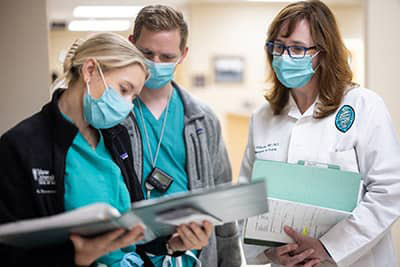 Our third-year students spend almost all of their academic time at various hospitals completing what are known as Clerkships. A clerkship is an immersive experience during which third-year students become part of a treatment team providing care in a specific area of medicine, such as Ob-Gyn or Pediatrics. The hospital team consists of an attending (faculty) physician, a resident (a licensed physician in training for that specialty), an intern (a licensed physician in the first year of training after medical school), sometimes a 4th year student serving as an acting intern in that specialty, and two or three 3rd year students. Though they are at the bottom of this hierarchy, the T3 students are an integral part of the team and usually have the most time to spend with the patient. Third-year students arrive early in the morning, make rounds on their patients, confer with the residents in preparation for attending rounds, present the patients’ histories and status during attending rounds, and assist with other duties following morning rounds. Depending on the specialty and patient census, attending rounds may last as long as three hours. In addition to learning about the patients’ diseases, the T3 student also becomes familiar with the culture of the hospital, becomes a strong patient advocate, gains further exposure to ethical issues, and learns to function as a part of an extended team. The clerkships include Surgery, Internal Medicine, Ob-Gyn, Family Medicine, Pediatrics, Neurology, and Psychiatry. All of the clerkships last 8 weeks, except for Family Medicine (6 weeks) and Neurology and Psychiatry (4 weeks each.) On the last day of each clerkship, students must take and pass a two-hour multiple choice National Board exam in that specialty. The exam is quite comprehensive, and students spent most of their evenings during clerkships studying for this exam. Fortunately, our students are exposed to a great number of patients, so when they study about a disease its presentation can be reinforced by their own personal experience with a similarly affected patient. Most medical students everywhere love their clinical experiences. The comment of “This is why I went to medical school” is heard frequently, and it is during these clerkships that students often realize their passion for a given specialty.
Our third-year students spend almost all of their academic time at various hospitals completing what are known as Clerkships. A clerkship is an immersive experience during which third-year students become part of a treatment team providing care in a specific area of medicine, such as Ob-Gyn or Pediatrics. The hospital team consists of an attending (faculty) physician, a resident (a licensed physician in training for that specialty), an intern (a licensed physician in the first year of training after medical school), sometimes a 4th year student serving as an acting intern in that specialty, and two or three 3rd year students. Though they are at the bottom of this hierarchy, the T3 students are an integral part of the team and usually have the most time to spend with the patient. Third-year students arrive early in the morning, make rounds on their patients, confer with the residents in preparation for attending rounds, present the patients’ histories and status during attending rounds, and assist with other duties following morning rounds. Depending on the specialty and patient census, attending rounds may last as long as three hours. In addition to learning about the patients’ diseases, the T3 student also becomes familiar with the culture of the hospital, becomes a strong patient advocate, gains further exposure to ethical issues, and learns to function as a part of an extended team. The clerkships include Surgery, Internal Medicine, Ob-Gyn, Family Medicine, Pediatrics, Neurology, and Psychiatry. All of the clerkships last 8 weeks, except for Family Medicine (6 weeks) and Neurology and Psychiatry (4 weeks each.) On the last day of each clerkship, students must take and pass a two-hour multiple choice National Board exam in that specialty. The exam is quite comprehensive, and students spent most of their evenings during clerkships studying for this exam. Fortunately, our students are exposed to a great number of patients, so when they study about a disease its presentation can be reinforced by their own personal experience with a similarly affected patient. Most medical students everywhere love their clinical experiences. The comment of “This is why I went to medical school” is heard frequently, and it is during these clerkships that students often realize their passion for a given specialty.
You may hear your student speak of the “donut,” a term which refers to the group of students rotating together on the same schedule throughout the year. Students become close to their fellow students on their same donut, but they certainly do have the opportunity to socialize with other classmates when not on-call at the hospital. To maintain balance, some students join a band or play team sports, and others explore the architecture or cuisine of New Orleans. Many even catch a few parades during the Mardi Gras season, even if they have to miss the huge Bacchus or Endymion parades the weekend before Fat Tuesday because they are on-call at the hospital.
Though students and residents cannot exceed 80 hrs./week at the hospital due to training rules, the days and on-call (admitting) nights are long. It is during this year that students may experience their first patient death from chronic disease or participate in CPR involving one of their team’s patients who experienced a cardiac arrest. Though they are maturing in matters of judgment, clinical skills, and professional values, the assumption of team responsibility and the uncertainty over a future specialty choice can add stress to a third-year medical student’s life. Nevertheless, at the end of third year the light at the end of the tunnel typically grows brightly for T3 students as their specialty choices and mentor relationships take form.
See the entire curriculum calendar: https://medicine.tulane.edu/education/undergraduate-medical-education/curriculum
